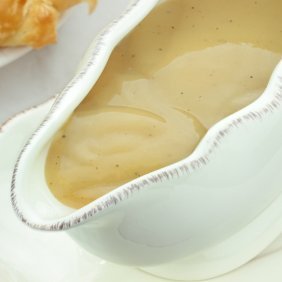The History
Roux is a thickening agent that combines a starch and a fat, used for sauces and soups. The use of this combination goes back at least three centuries in French cuisine – but this technique has been documented to be used much earlier in other cuisines such as Asian cooking with the use of ground rice and pork fat.
Basic Options
There are four basic varieties: white, blond, brown, and dark brown, depending on how long the roux is cooked (going from shortest to longest). Most cooking calls for blond or brown; Cajun and Creole cooking use dark brown roux. Brown and dark brown have more flavor, but they have less thickening power.
Fats Add Flavor
Any fat or oil can be used to create a roux: clarified butter (the most common and versatile), rendered animal fats (such as bacon grease or rendered duck fat), or pan drippings from a roast (beef, turkey, or chicken).
The Starch
Our favorite is “OO” Italian flour, which gives a silky texture, but any wheat flour will work. We have experimented with potato, chickpea, lentil, and rice flours. If you want a gluten-free gravy, try rice flour – with the warning that it will not be tasting the same, and it can be a bit gritty. If you want a good gluten-free gravy, then you probably will skip the roux-making step, and go right to thickening with cornstarch or arrowroot – click HERE to see the Bon Appetit article on gluten-free gravy.
Directions for Basic Roux
- Melt 1 cup of clarified butter in a saucepan over medium heat. Once the butter is hot enough that a pinch of flour sprinkled over the top will slowly start to bubble, then whisk in 1 3/4 cups of flour. Whisk constantly until smooth.
- A white roux is reached when the flour looses its raw smell, about 5 minutes after the flour has been added. The mixture should be vigorously bubbling.
Blond Roux
- Cook for about 20 minutes after adding the flour, while stirring – the roux will look tan colored, and smell a bit like toasted bread. It will be smooth, bubbling, and a bit thinner than the white roux.
Brown Roux
- Cook for about 35 minutes after adding the flour, while stirring – the roux will look brown colored, and smell nutty. It will be smooth, be bubbling slightly, and a bit thinner than the blond roux.
Dark Brown Roux
- Cook for about 45 minutes after adding the flour, while stirring – the roux will look melted milk chocolate, and smell a bit like chocolate. It will be smooth, and a bit thinner than the brown roux; it will no longer be bubbling.
When you are making a gravy from roasted meat drippings, put the appropriate amount of flour into the hot pan over medium heat. The amount of flour you use will depend on the amount of pan drippings – a good estimate is based on the above recipe (a ratio of fat to flour of 1 to 2). Make sure that you take the time to cook the roux until at least blond before adding liquid (stock, wine, etc.). Click HERE to see our recipe for beer gravy.


